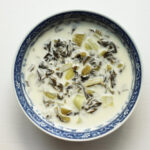booshala | swiss chard, rice, and yogurt soup

- Prep Time: 35 minutes
- Total Time: 1 hour (17 hours if making your own yogurt)
- Yield: 8 servings
Ingredients
- 1/2 cup medium grain rice
- 2 quarts of plain, unstrained whole milk yogurt (either homemade or store-bought) *
- 3 cups water, or more if necessary
- 1 egg
- 1 1/2 to 2 teaspoons salt (to taste)
- 7 celery stalks, chopped into about 3 cups
- 2 banana peppers or 3 small hot peppers (such as jalapeño or güero), chopped (if you want to make it milder, remove some or all of the waxy pith)
- 1 large bunch Swiss chard, chopped into about 6 to 7 cups of bite-sized pieces (?)
Instructions
- Rinse the rice under cold water and add it to a stockpot.
- Add the yogurt, water, egg, and salt to the pot. Whisk everything together until the liquids are completely combined.
- Add the celery, peppers, and Swiss chard to the pot.
- Turn the heat up to medium-high and stir constantly until it comes to a simmer. This should take about 20 to 25 minutes. Do not stop stirring and keep an eye on it to make sure you turn the heat down as soon as you see bubbles.
- As soon as it begins to simmer, turn the heat to very low and cook for about 8 more minutes, until the rice is cooked through and the vegetables are al dente. Stir occasionally and keep the pot uncovered while it cooks. If it looks too thick, add between 1/4 and 1/2 cup of water.
- Serve either hot or chilled, depending on your preference or the weather. **
Notes
* If you’re making your own yogurt: make a half recipe of plain, unstrained yogurt (you will use 1/2 gallon of milk and 1/2 cup plain yogurt). Follow the instructions as written in my homemade yogurt recipe, but leave the yogurt to ferment for somewhere between 12 to 16 hours, depending on how sour you want the soup to be. Sometimes I like to make a full gallon of yogurt, and then divide it in half. I use one half to make labneh and the other for booshala. I’ve heard that in Syria, my family would add some of the whey from the labneh back into the booshala in place of the water. I’ve never tried it myself, but it might be worth experimenting with, especially if you’re looking for ways to reduce food and water waste.
** I like to serve a big chilled stockpot of booshala, and then I microwave individual bowls for people who want theirs hot (and in case you’re wondering, I prefer eating hot booshala).
Find it online: https://cardamomandtea.com/92/booshala/
